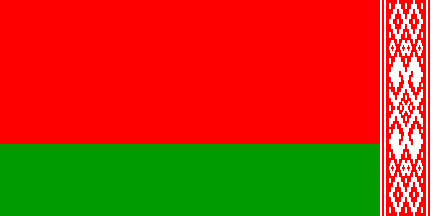
image by Željko Heimer and Zach Harden, 17 Jul 2001 |

Last modified: 2009-09-12 by antónio martins
Keywords: byelorussian ssr | belarus | error | hammer and sickle (yellow) | hammer and sickle (black) | star: 5 points (fimbriated) | sun: rising | national ornament | guseŭ (m. i.) | markeviĉ (matrona) |
Links: FOTW homepage |
search |
disclaimer and copyright |
write us |
mirrors

In all sources I saw the ornament has two thin white stripes at the fly part (Soviet Encyclopedia 1962; Basov and Kurkov’s Flags of Belarus yesterday and today [bku94]). Unfortunately, I have no official Regulations. The Decree of 25, December, 1951 says:
The flag consists of two horizontal stripes. Upper stripe is red (2/3 of flag-height), lower stripe is green (1/3 of flag-height). The gold hammer and sickle and red star with gold border in left upper corner of the red stripe. The belorussian national ornament is at the hoist part (white on red background). Width of the ornament is egual to 1/9 of flag-length.Victor Lomantsov, 25 Jan 2001
RSFSR had the only SSR flag with only
non-horizontal stripes, while Byelorussia had the only one with both.
Steve Stringfellow and António Martins, 12 and 13 Mar 2000

In the end of the 1940s, the political need had arised to have somewhat visually different designs of the flags of the USSR republics, especially for those being the UN members. For the BSSR flag, the image of the Belarusian folk design had been finally chosen as a distinctive feature of the flag. Then the picture of the embroidery on the ручник (handtowel) had been found in the pre-WW2 archives of the Belpramsavyet. The embroidery had been made in 1917 by peasant Ms. Матрона Маркевич (Matrona Markeviĉ) of the village Касцилища (Kascilixa) of the Sennin region, and had been named «The Rising Sun». Artist М. И. Гусеў (M. I. Guseŭ) had prepared the project of the BSSR flag, basing it on the embroidery, with several symbolic elements added.
Symbolically, the design on the BSSR flag is decoded as follows:
Yury Tarasievich, 08 Jun 2006
 image by Željko Heimer and Zach Harden, 17 Jul 2001 | |
No hammer, sickle and star on the
reverse side.
Mark Sensen, 25 May 1997
Officially reverse looked like obverse without star and hammer-sickle.
But in fact I never saw these flags without star, hammer-sickle. Real flags
(all 15) usually were either with reverse analogous
to obverse (but with star and hammer-and-sickle near the hoist) or with
reverse = mirrored obverse.
Victor Lomantsov, 30 Nov 2002
by.gif)
The emblem of the SSR was used until 10 December 1991, when the
coat of arms with the horseman was
introduced; Hesmer [hes92] does not
mention the introduction date of the SSR coa.
The current emblem (introduced 1995) is
basically the same as the old SSR one, with only two changes.
Marcus Schmöger, 16 Sep 2001
In the book A Day in the life of the Soviet Union
which was made in 1987, there is a photo of Byelorussian
schoolchildren exercizing under «The flag of the Soviet
republic of Byelorussia». However, this is not the
red and green flag that was adopted as the Soviet republic’s
flag in 1951, nor is it the current flag
of Belarus: Instead, this flag has a light green bar at
the base that goes up about 1/4 the hoist.
C. C. C. P. Robert, 03 Aug 1998
It looks like a Lithuanian SSR
flag. I bet that the photo was taken near the border line
and the writer mixed up in which side of it he was…
António Mastins, 15 Dec 1999
Anything below this line was not added by the editor of this page.